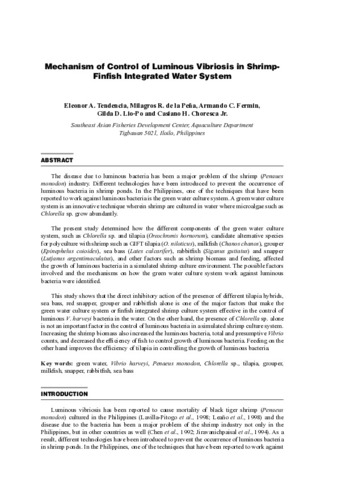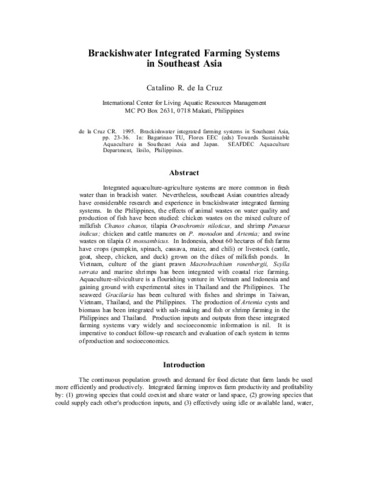Mechanism of control of luminous vibriosis in shrimp-finfish integrated water system
- Global styles
- MLA
- Vancouver
- Elsevier - Harvard
- APA
- Help

วันที่
2005-03ผู้เขียน
Page views
6,066ASFA keyword
AGROVOC keyword
Taxonomic term
เมตาดาต้า
แสดงระเบียนรายการเต็ม
Share
นามธรรม
The disease due to luminous bacteria has been a major problem of the shrimp (Penaues monodon) industry. Different technologies have been introduced to prevent the occurrence of luminous bacteria in shrimp ponds. In the Philippines, one of the techniques that have been reported to work against luminous bacteria is the green water culture system. A green water culture system is an innovative technique wherein shrimp are cultured in water where microalgae such as Chlorella sp. grow abundantly.
The present study determined how the different components of the green water culture system, such as Chlorella sp. and tilapia (Oreochromis hornorum), candidate alternative species for polyculture with shrimp such as GIFT tilapia (O. niloticus), milkfish (Chanos chanos), grouper (Epinephelus coioides), sea bass (Lates calcarifer), rabbitfish (Siganus guttatus) and snapper (Lutjanus argentimaculatus), and other factors such as shrimp biomass and feeding, affected the growth of luminous bacteria in a simulated shrimp culture environment. The possible factors involved and the mechanisms on how the green water culture system work against luminous bacteria were identified.
This study shows that the direct inhibitory action of the presence of different tilapia hybrids, sea bass, red snapper, grouper and rabbitfish alone is one of the major factors that make the green water culture system or finfish integrated shrimp culture system effective in the control of luminous V. harveyi bacteria in the water. On the other hand, the presence of Chlorella sp. alone is not an important factor in the control of luminous bacteria in a simulated shrimp culture system. Increasing the shrimp biomass also increased the luminous bacteria, total and presumptive Vibrio counts, and decreased the efficiency of fish to control growth of luminous bacteria. Feeding on the other hand improves the efficiency of tilapia in controlling the growth of luminous bacteria.
การอ้างอิง
Tendencia, E. A., de la Peña, M. R., Fermin, A. C., Lio-Po, G. D., & Choresca, Jr., C. H. (2005). Mechanism of control of luminous vibriosis in shrimp-finfish integrated water system. In K. Nagasawa (Ed.), Recent Advances in Diagnosis and Prevention of Fish and Shrimp Diseases in Southeast Asia (pp. 197–221). Tigbauan, Iloilo, Philippines: Aquaculture Department, Southeast Asian Fisheries Development Center.
Type
Book chapterISBN
9718511732
Related items
Showing items related by title, author, creator and subject.
-
Aquaculture in the Philippines
Aypa, Simeona M. (Aquaculture Department, Southeast Asian Fisheries Development Center, 1995)Aquaculture is regarded as the most promising source of protein food in the years ahead. Milkfish and Nile tilapia are the major fishes now produced but groupers, sea bass, rabbitfish, red snappers, carps, and catfishes ... -
Management of feeding aquaculture species
Alava, Veronica R. (Aquaculture Department, Southeast Asian Fisheries Development Center, 2002)This chapter teaches the reader to: differentiate the different feeding strategies in pond culture; learn feeding management methods such as stock sampling and record keeping, calculating daily feed ration, choosing ... -
Brackishwater integrated farming systems in Southeast Asia
De la Cruz, Catalino R. (Aquaculture Department, Southeast Asian Fisheries Development Center, 1995)Integrated aquaculture-agriculture systems are more common in fresh water than in brackish water. Nevertheless, southeast Asian countries already have considerable research and experience in brackishwater integrated farming ...

 AQD Access
AQD Access





